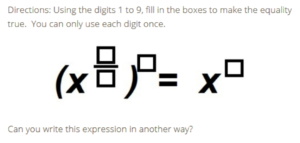Open the Middle of Problems for Students

Bryan Anderson
Bemidji Area Schools
There are a lot of math resources floating around on the internet and it’s very hard to keep up with them all. What standards does it address? How will I use this in class? How will it impact my students? How will it engage my students? Will I have time to use it? There are so many questions that float through my head when I see something new that piques my interest. Let’s look at one of those resources, Open Middle.
Open Middle sprang from the mind of Robert Kaplinski after attending to Dan Meyer’s talk Video Games and Making Math More Like Things Students Like.
What makes an Open Middle Problem?
- they have a “closed beginning” meaning that they all start with the same initial problem.
- they have a “closed end” meaning that they all end with the same answer.
- they have an “open middle” meaning that there are multiple ways to approach and ultimately solve the problem.
Open Middle problems are valuable in the classroom for many reasons. The most important feature of Open Middle problems is that they are low entry. The directions and set-up of problems provide students with enough structure to start the problem. This structure allows all students to feel safe and comfortable to engage in the problem and explore the mathematics behind it. Open Middle problems challenge students by presenting a problem in the form of a puzzle. When students think of problems as puzzles and not as an assignment, they are more apt to persevere through failure. Another feature is Open Middle problems are non-routine. They challenge students to think about problems beyond finding an answer. In order to solve them students have to understand the mathematics behind them. Open Middle problems often ask for optimization. In addition to finding a solution, students are typically asked to find the largest or smallest value. This type of optimization promotes critical thinking and justification skills, allowing students to construct arguments to justify their observations and work. This leads into another important feature of Open Middle problems- their ability to generate classroom discourse. By providing students with a problem that can be solved in multiple ways, you create an environment where students want to share their thinking and strategies. Open Middle problems are a perfect gateway for rich classroom discussions.
How can you use these problems in your classroom? The means in which you implement the problems depends on you, your classroom structure, and your lesson design. I have used these problems in a variety of ways. I use them as bell work, having these problems posted on the board when students enter. When I use them in this manner, I chose problems that can be used to activate prior knowledge for the lesson. This typically means I will choose problems from lower grades. I also use Open Middle problems as homework. Instead of assigning students a problem set of 20 to 30 problems, I will give them an Open Middle problem- and usually provide an extra optimization parameter. By using these as homework problems, I have not had students come into my classroom with unfinished homework. The final way I have used these problems is as purposeful practice during a lesson. After providing instruction on the concept of the day, I split students up into small groups and have them work on an Open Middle problem. I can then check in with each group and listen to student ideas and thinking. I use this strategy early in the year because students are sharing their ideas to a smaller audience, which builds confidence in verbalizing their mathematical thinking before having to present their ideas to the whole class.
Problems on the Open Middle site are categorized by grade level and math strand. They are aligned to the Common Core State Standards, although mapping those back to the Minnesota State Math Standards is an easy task. Take the time to visit openmiddle.com, you will find that it is a resource that can make an immediate impact on you, your students and your classroom. You will find that students will look forward to these problems, and may even surprise you by developing ones of their own!
